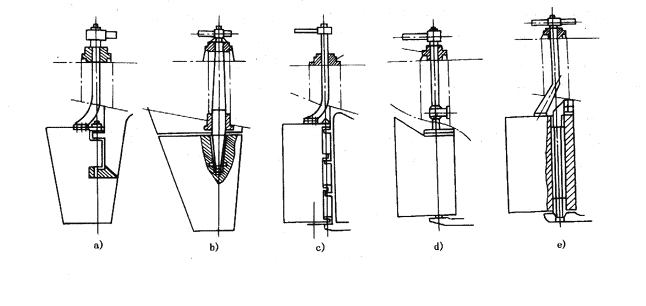
Determination of the number and type of marine rudder
The number of rudders is not only related to maneuverability requirements, but also to the shape of the stern and the number of propellers. Although increasing the number of rudders can easily meet higher maneuverability requirements, it also leads to more complex and expensive rudder equipment. Therefore, in practical use, except for special requirements, there is always a tendency to take the minimum number of helmets.
In general, in order to improve steering efficiency, the rudder is always placed behind the propeller, keeping it in the wake of the propeller. Therefore, single propeller single rudder and double propeller double rudder are widely used on ships, and the vast majority of ocean transport ships are single propeller single rudder.
Overview
The number of rudders is not only related to maneuverability requirements, but also to the shape of the stern and the number of propellers. Although increasing the number of rudders can easily meet higher maneuverability requirements, it also leads to more complex and expensive rudder equipment. Therefore, in practical use, except for special requirements, there is always a tendency to take the minimum number of helmets.
In general, in order to improve steering efficiency, the rudder is always placed behind the propeller, keeping it in the wake of the propeller. Therefore, single propeller single rudder and double propeller double rudder are widely used on ships, and the vast majority of ocean transport ships are single propeller single rudder.
Due to certain special considerations, some ships may have varying numbers of rudders and propellers. In order to prevent serious damage to the rudder of ships sailing in ice regions, and to simplify rudder equipment, some giant passenger ships are equipped with double propellers and single rudders. In this case, its maneuverability is slightly worse than that of ships with the rudder set behind the propeller. On shallow draft ships, increasing the number of rudders to ensure sufficient rudder area and appropriate aspect ratio has led to the emergence of single propeller three rudders and double propeller three rudders.
Unbalanced rudder is usually installed behind the rudder post of single propeller ships, and some double propeller ships or non self-propelled ships also have unbalanced rudder installed behind the dead wood in the mid longitudinal section. These rudders are supported by one or more rudder pins and are commonly used on ships sailing in dense or large areas of broken ice.
A single bladed ship without a rudder pillar equipped with a guide frame bottom bone is often equipped with a balance rudder supported by the rudder heel to reduce the turning torque.
A semi suspended rudder, also known as a Mariner rudder, is widely used in twin propeller single rudder ships, single propeller single rudder ships without tail columns, and multi propeller multi rudder ships, and the rudder is supported by rudder pins on solid wood or rudder arms. Dead wood or rudder arms can improve the heading stability of ships and compensate for the poor hydrodynamic characteristics of semi suspended rudders, because the hydrodynamic characteristics of rudders, including some dead wood or rudder arm areas, are almost the same as those of ordinary rudders with the same area and aspect ratio.
Suspended rudder is used on single propeller or multi propeller ships without tail columns, and should be placed as far behind the propeller as possible. Due to the large bending moment borne by the rudder stock (especially for flap rudder), in order to reduce the diameter of the rudder stock, the lower rudder support should be installed as close to the bottom of the ship as possible.
Some ships that require good maneuverability during reverse navigation, such as ferries, tugboats, etc., can be equipped with a bow rudder or a reverse rudder. The first rudder is generally inefficient and is rarely used. These types of ships are currently mostly equipped with fully rotating ducted propellers (Z-type thrusters) or lateral propulsion devices.

For more marine rudder system information, kindly please click here.





